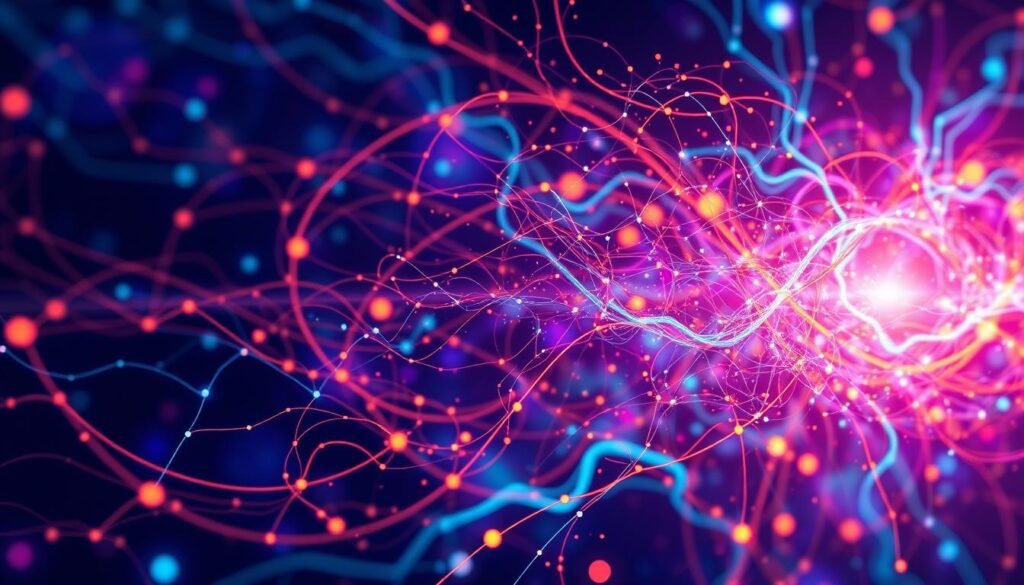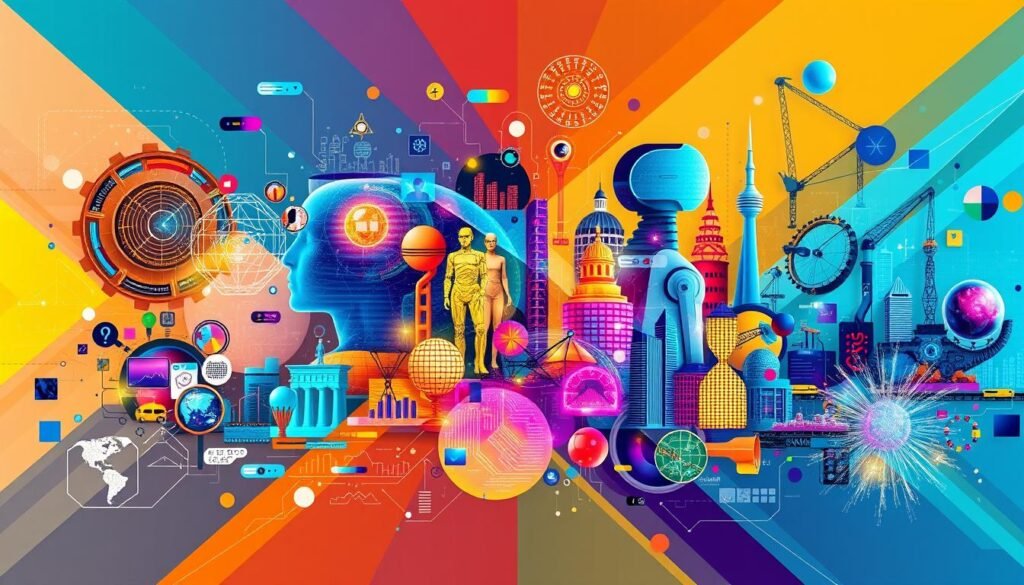Did you know an image made with latent space models can show most of what’s in the prompt in just 10-15 steps? More steps add more detail. This shows the power of AI latent space fusion. It’s changing artificial intelligence and machine learning.
This technology combines artificial intelligence, machine learning, and data fusion. It leads to new ideas, like making fake medical images or original music. Expect big changes in fashion, gaming, and marketing as Generative AI gets more use.

Key Takeaways
- AI latent space fusion is a powerful technology that combines artificial intelligence, machine learning, and data fusion techniques.
- Within 10-15 steps, an image generated using latent space models can encompass most of the features described in the prompt.
- AI latent space fusion is transforming various industries, including fashion design, gaming, and marketing.
- Generative AI can create innovative solutions, such as synthetic medical images and original music.
- The integration of AI latent space fusion across industries is driving innovation and transforming traditional processes.
- AI latent space fusion has the potential to revolutionize the field of artificial intelligence and machine learning.
- AI latent space fusion enables the creation of high-resolution images and videos, enhancing the quality of visual content generation.
Understanding AI Latent Space Fusion Fundamentals
As you explore AI, you’ll learn about neural networks and deep learning. These are key to grasping latent space fusion. This method combines data from different sources to make models stronger and more flexible. In data science, latent space is a simplified version of data patterns. It lets generative models create new versions of original content.
Generative AI models, like those using neural networks, learn from big datasets. They can then make new content that looks like what they learned from. These models can change many fields, like art, entertainment, medicine, and business. By fusing data, AI can make new content, finish code, generate images, change images, and even create virtual worlds.
In AI, methods like zero-shot and few-shot prompting make Language Model Models (LLMs) more reliable. Good prompt engineering boosts model efficiency and performance. As you learn about latent space fusion, you’ll see how data science and deep learning are vital for AI innovation.
Generative AI has many uses, including:
- Image synthesis and editing
- Text generation
- Music composition
- Content creation
These uses rely on neural networks, data science, and deep learning. They allow AI to create new and creative content.
The Evolution of AI Latent Space Technology
Exploring AI latent space technology reveals the importance of data fusion and algorithm optimization. The journey of latent space models has seen major milestones. From the start with autoencoders to today’s AI latent space fusion.
Latent space in AI makes data representation simpler. It helps in finding patterns and spotting anomalies. Industries like automotive, aerospace, and healthcare will see big benefits from these advancements.
Some key uses of latent space AI include:
- Image generation
- Anomaly detection
- Dimensionality reduction
Recent studies aim to improve the quality and variety of generated images. Techniques like hierarchical latent variables and better posterior approximations are being explored. The use of data fusion and algorithm optimization has led to more efficient models, like Variational Autoencoders (VAEs).

The future of AI latent space technology looks bright. It could help in areas like self-driving cars, design, and learning from less data. As you delve deeper, you’ll see how algorithm optimization and data fusion are key to its success.
| Application | Benefit |
|---|---|
| Autonomous Vehicle Systems | Enhanced predictive maintenance capabilities |
| Design Optimization | Improved product configurations |
| Semi-Supervised Learning | Enhanced model performance with unlabeled data |
Implementing AI Latent Space Fusion in Your Projects
To start with AI Latent Space Fusion, you need to know the key tools and frameworks. These help in making latent space models. This technology can change how you solve complex problems. With the right help, you can use it to innovate in your projects.
Exploring AI Latent Space Fusion, you’ll see how computational intelligence is key. It helps in making models that mix different ideas and find new solutions. Variational Autoencoders (VAE) and reinforcement learning (RL) help improve designs and create images that people like.
When using AI Latent Space Fusion, keep these points in mind:
- Evaluate images based on how many dimensions are mixed
- Use colors that go well together to make images look better
- Think about how colors affect how people feel about the images
Studies show AI Latent Space Fusion works well. It gets high user satisfaction and high SSIM scores. Using this technology and computational intelligence in your work can open up new possibilities and lead to innovation.
With the right tools and frameworks, you can beat common problems and succeed with AI Latent Space Fusion. It can change your work in design, engineering, or other fields. This technology has the power to make a big difference in your work.
| Model | Accuracy | Loss Reduction |
|---|---|---|
| VAE | 93% | 0.07 |
| RL | 92% | 0.08 |
Revolutionary Applications Across Industries
Artificial intelligence is changing many fields, from healthcare to finance and manufacturing. Machine learning and neural networks help solve big problems. For example, AI can look at medical images and find diseases faster and more accurately.
In finance, AI spots fake transactions and guesses market trends. In making things, AI helps design faster and cheaper, with more accuracy. Designing things goes through three main steps: planning, ideas, and details.
Some cool uses of AI Latent Space Fusion include:
- Comprehensive diagnostics and personalized treatment plans in healthcare
- Adaptive learning platforms and virtual tutors in education
- AI-assisted content creation and immersive experiences in entertainment and media
- Enhanced customer service with omnichannel support and personalized shopping experiences

The possibilities with AI Latent Space Fusion are endless. By using machine learning and neural networks, many areas can get better. AI is making healthcare better and customer service more personal. It’s changing how we live and work.
| Industry | Application | Benefits |
|---|---|---|
| Healthcare | Comprehensive diagnostics | Improved accuracy and speed |
| Finance | Fraud detection | Reduced risk and increased security |
| Manufacturing | AI-supported design | Reduced design time and costs |
Optimizing Performance Through Advanced Techniques
To boost your AI Latent Space Fusion models, use data science and deep learning tricks. Fine-tune your models with algorithm optimization like gradient descent. This makes them work better.
Here are some top tips for better performance:
- Use L1 or L2 regularization to avoid overfitting
- Apply early stopping to stop overtraining and boost generalization
- Try batch normalization to stabilize your input data
These methods can make your AI models more accurate and efficient. Forge can also help optimize your models for various hardware. This lets AI models work on more platforms than before.
Also, SpaceFusion can align different neural network spaces. This uses patterns in each space to enhance AI model performance. With these tools and techniques, you can tweak your models for faster and more efficient AI applications.
| Technique | Description |
|---|---|
| SpaceFusion | Aligns different latent spaces of neural networks to leverage embedded patterns |
| Forge | Optimizes models for different hardware platforms, expanding AI model applications |
Conclusion: The Future of AI Fusion Technology
As we wrap up our look at AI Latent Space Fusion, it’s clear this tech has huge potential. It’s changing the world of artificial intelligence fast. With quick growth in generative AI, like OpenAI’s ChatGPT, and new uses, the future looks bright.
AI Latent Space Fusion combined with extended reality (XR) will bring us closer to real, personal experiences. This will change many fields, from shopping to learning. You’ll see more realistic 3D content, better user interactions, and experiences that really grab your attention.
As AI Latent Space Fusion keeps growing, it’s important to keep up with new methods. By diving into these new areas and helping shape the tech, you can find new ways to solve big problems. This will lead to innovation in many areas.
FAQ
What is AI Latent Space Fusion?
AI Latent Space Fusion combines AI’s latent space models with data fusion. It helps solve complex problems and boosts innovation in many fields.
How does latent space relate to AI and neural networks?
In AI, latent space is a hidden, compressed data representation. Neural networks learn this to grasp data’s key features. This lets AI systems discover new insights and abilities.
What is the importance of data fusion in AI systems?
Data fusion is key in AI, merging different data sources for stronger models. AI Latent Space Fusion finds hidden patterns, improving performance and decision-making.
How has AI Latent Space Technology evolved over time?
AI Latent Space Technology has grown with better data fusion and algorithms. Researchers and developers have made big strides, leading to today’s AI Latent Space Fusion.
What are the essential tools and frameworks for implementing AI Latent Space Fusion?
Tools like deep learning libraries and data fusion platforms help build AI Latent Space Fusion models. These resources are crucial for integrating this technology into your projects.
How can AI Latent Space Fusion be applied across different industries?
AI Latent Space Fusion is useful in many industries, from healthcare to finance. It helps solve complex issues, improve decision-making, and open new innovation paths.
How can I optimize the performance of my AI Latent Space Fusion models?
To boost AI Latent Space Fusion model performance, fine-tune your models and scale your systems. Use the right metrics and evaluation techniques. These steps help refine your AI Latent Space Fusion.
Also Read
Free captcha generator website source code using html css and javascript
Adaptive Recurrent Graph Networks
E learning website project with source Code using HTML CSS and JavaScript 2024-25
